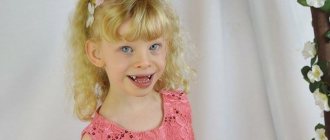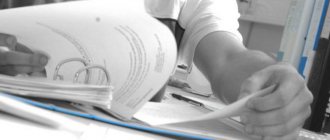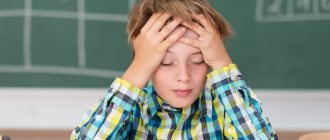Why do we need a psychological and pedagogical characteristic for a student?
The psychological and pedagogical characteristics of the student are written with maximum consideration of the individual aspects of the development of each child, describing in detail his psychological characteristics. This is explained by the fact that it plays a very important role in the educational process, significantly simplifying the interaction of the school’s teaching staff with the student. Allows the teacher to get an initial idea of the student and choose the most beneficial strategy for interacting with him.
In addition, such characteristics may be required when transferring to another school or college; they are requested by the guardianship authorities, the police and the PDN, and the military registration and enlistment office.
Rules for conducting psychological and pedagogical examination
There are fairly clear rules for drawing up a student’s characteristics. One of the fundamental requirements for conducting psychological and pedagogical characterization is objectivity . It is equally important to carefully analyze the factors influencing a child’s development as a whole, taking into account the characteristics of the student. The child should be treated as delicately as possible, minimizing any coercion or pressure on him. Only in this case can a psychological and pedagogical characterization of a student or student be as objective and useful as possible.
The student's characteristics are written by the class teacher and signed by the school director. When writing a psychological profile of a child, you may need the help of a school psychologist, testing and diagnostic results.
Mandatory subparagraphs
It is necessary to know the rules for writing characteristics, because... If they are violated, the document drawn up may have no legal force. The document consists of 3 parts.
In the upper right corner (or in the center of the sheet) indicate the personal data of the child for whom the characteristics are being compiled:
- Child's full name;
- place of study, class;
- date of birth, place of residence.
The next part of the document contains the following information:
- date the child entered school;
- the general level of knowledge at the beginning of studies and the acquired skills at the time of writing the characteristics, which subjects are more successfully mastered, what are the difficulties;
- features of thought processes, memory, attentiveness;
- level of health and physical activity;
- psychological adaptation in a team, relationships with peers, teachers;
- student motivation to study.
General reasonable conclusions and forecasts of the author's characteristics. Date/signature.
How to write a reference for a student
Let's consider what a typical psychological and pedagogical profile drawn up for a secondary school student should look like. The content of the characteristic may depend on the person who requires it. The minimum volume of the characteristic is 800-900 characters, the maximum volume is not limited, and, as we said above, the characteristic can contain reports on work with the student, test results.
- At the beginning, indicate the student’s last name, first name and patronymic, the class in which he is studying, and the characteristics of his health group.
- If desired, you can also indicate the most striking external features. This data can be obtained by organizing a conversation with both the student himself and his parents.
- It is equally important to indicate the composition of the student’s family, features of social status, and the quality of interaction.
- After this, you can move on to studying the child’s personal characteristics, covering his attitude to school (hard work, perseverance, academic performance) and to others (development of communicative competencies, ability to communicate with peers and with adults). Data can be obtained both through observation and conversation with the child, and through projective techniques (drawing tests, etc.).
- The psychological and pedagogical characteristics of a student should contain information about his resistance to stress, level of development of thinking and speech, emotionality, attention, and punctuality.
- It is necessary to indicate how high the child’s social status is and whether he easily establishes social contacts.
- At the end of compiling the characteristics, you need to summarize the development of the student and the correspondence of his level to age characteristics. Recommendations related to upbringing, training and further interaction with the child are given.
The characteristics that will be transferred to a third-party organization are written on school letterhead, with the date and signature of the person who prepared it and the signature of the school director at the bottom.
The purpose of using a psychological portrait
A psychological portrait is important in choosing a life path and future profession. It is drawn up before entering the university, since this is the time to determine further activities. Using a psychological portrait of a person will help you find “your” activity, from which he will receive not only profit, but also pleasure.
In addition, a psychological portrait is a tool that allows you to get to know a person better, his abilities, and behavioral characteristics. It helps to identify the strengths and weaknesses of an individual, his tendencies to lies and conflicts.
To be confident in yourself, to be able to defend your position and identify lies from your interlocutors, you need competent work from a specialist, for example, the psychologist-hypnologist Nikita Valerievich Baturin.
Many job candidates undergo testing conducted by HR managers. Its purpose is to determine the personal qualities and professional abilities of a potential future employee. A ready-made psychological portrait of a person helps managers recognize and predict a person’s actions in a specific difficult situation, his ability to solve emerging problems, and identify the qualities necessary for an employee occupying a certain position.
In relation to children, a psychological portrait helps teachers find the optimal approach to them. For parents, it is important in terms of knowledge of child psychology, determining the correct course of raising a child in accordance with his temperament.
Today, people often ask psychologists to create a psychological profile in order to identify similar qualities of a potential life partner. The previously known rule “plus and minus attract” no longer applies. It is known that people with opposite characters will not be able to find a common language. To avoid disputes and conflicts, partners must have similar temperaments, similar values, and goals.
Sample characteristics for a student
You can view ready-made characteristics for a student on our website - select a sample characteristics below. The development will help the class teacher quickly and efficiently draw up a character reference for a student. You can create a complete description according to the plan on this page.
Sample pedagogical characteristics for a primary school student
Sample characteristics for a primary school student from a teacher, required when passing a psychological and pedagogical commission at any level. The characteristics are written in two copies, signed by the teacher and the director, and the school seal is required.
Up
Psychological and pedagogical characteristics surname first name.
Full Name:
Date of Birth:
Father:
Mother:
Residence address: ………………….telephone….
School No. class
He has been studying at school No. since one year (retained for a repeat course in the class);
studied at school no.
Psychological characteristics of cognitive processes
General motor skills are characterized by (in)sufficient voluntary control of movements, fine motor skills are well/weakly developed.
The perceptual function is not sufficiently developed, the child (not) experiences minor difficulties when acting according to a visual model/verbal instructions. Perception is better/worse developed than thinking.
Attention is (un)sustainable and (un)exhaustible, voluntariness, concentration and switchability are reduced/within the age norm.
Visual memory, short-term and long-term, is (not) sufficiently developed. Voluntary short-term memory is (not) high. Medium/high/low level of mechanical memory, level of logical memory lower/higher. When memorizing, he quickly gets tired/memorizes (small) large/medium amounts of text.
Visual-effective and visual-figurative thinking are better/worse developed than verbal-logical thinking/correspond to the norm for a given age.
(not) Disorders of oral speech development and phonemic hearing are detected. Articulation (“blurred”/pronunciation of sounds in syllables and words is unclear/agrammaticalisms are frequent/inconsistency).
The level of conceptual development and orientation in the surrounding world is (in)sufficient/appropriate for age.
In general, the child is characterized by (increased fatigue/unstable attention/predominance of inhibition processes over excitation processes).
Pedagogical characteristics of educational activities.
The child is studying in a mass class/is receiving individual instruction… for a year.
Literary reading. Reading rate ... words per minute (norm at the end of the first/second half of the year ... words). Reading (not) sufficiently conscious, but little expressive/not expressive/expressive), without/with observance of logical pauses and intonation at the end of the sentence. Makes many mistakes (the nature of the mistakes), (but does not) repeat them when re-reading the text. A detailed/brief/creative retelling of the text is difficult, omits details, descriptions, the story is little/quite emotional. He reads poems by heart with errors, (not) expressively enough. Gives complete/expanded/monosyllabic answers to questions, makes (minor) mistakes when establishing cause-and-effect relationships. Vocabulary is limited/age appropriate.
In the Russian language, he (doesn’t) know the rules well and (doesn’t) understand/doesn’t always understand how to apply them. Grapho-motor skills are (not) sufficiently developed, handwriting is different (careless/often very small/very large/uneven, (not) legible). The following errors appear in writing: (omissions and substitutions of letters (often similar in spelling or denoting similar sounds), unnecessary elements of letters, as well as their underwriting, agrammatism), which indicates a violation of the writing processes.
In mathematics, difficulties are caused by the development (graphical skills, counting skills, problem solving). Mathematical speech is (not) formed slowly/in full. The greatest difficulties are caused by (the formation of computational skills, which are at a low/medium level (counts within 10 without relying on clarity); mechanical memorization of the multiplication/addition tables is more successful). The specific meaning of the operations of multiplication and division/addition and subtraction is realized only when visualization is used. When solving problems, difficulties arise (explaining the choice of action, writing down explanations, omitting names).
Completes homework (not) in full, but under the control of parents/independently.
The pace of work in the lesson is (in)sufficient/low/medium/high when performing simple (of the same type) tasks independently/collectively; exercises that require switching attention (do not) cause a decrease in pace. The child is not very active in lessons, and creative tasks (do not) arouse interest.
There is no/low educational motivation. Self-control is poorly developed/within the age norm/highly developed; independent work skills are (in)sufficiently developed/developed with difficulty.
Relations with the teacher /calm/smooth/friendly; fulfills demands and instructions formally/willingly/sometimes reluctantly/with desire. He often reacts with restraint/(in)adequacy to comments and praise.
The child’s clothes are (un)tidy, writing materials and school items are in good/(un)satisfactory condition.
The child is (little) sociable, is (un)friendly with other children, (does not) participate in group games/is often a leader. There are/are no friends outside of school, hobbies(…), at school he participates in clubs(…), he attends outside school(…).
Parents comply with the teacher’s recommendations and requests (to the extent possible)/do not fulfill them.
Teacher______________/acting surname /
Director ____________/acting surname /
Up
Characteristics of a difficult student
The characterization of a difficult student requires a special approach from the teacher who composes it. Not only psychological knowledge, but also the ability to analyze the situation from different angles, revealing the main reasons for his low performance or difficult to educate. The social environment has a great influence on this:
- family influence (parents having addictions, criminal records, single-parent and large families, violence and conflicts in the family);
- low material well-being in the family;
- the presence of seriously ill close relatives who are in direct contact with the child;
- difficult life circumstances
An example of a characteristic for a difficult student
Up
Characteristics of a student in the __ class of the MBOU __________________ Secondary School
____________________, __.__._____ the year of birth,
residing at: _________________________
Ivan Ivanov has been studying at the Municipal Budgetary Educational Institution ________________ since __ grade. He has been on the school register since 2nd grade for violations of discipline. He was registered with the Commission on Minors' Affairs and Protection of Their Rights under the administration of the ________ district in 2016-2017 for causing harm to the health of a student at the _____________ school.
Composition of Ivan Ivanov’s family: mother – __________________ and father ____________________. The parents are currently living separately. Ivan lives with his mother in a rented apartment.
____________________'s mother works ________________ in _______________. The father does not participate in upbringing, does not help the family financially, and abuses alcohol.
Mother ____________________ answers the class teacher's calls, always comes to school at the invitation of the class teacher, teachers, and deputy directors, but does not always attend parent-teacher meetings. The mother overprotects Ivan, tries to satisfy all his needs and protects him from worries and efforts, and does not control Ivan’s academic work and behavior enough.
Ivan is outwardly neat, well dressed, has all the necessary school supplies and textbooks provided to him for use by the school.
Ivan's intellectual capabilities are low. The attitude towards studying is negative. He was conditionally transferred to the 6th grade with academic debt in mathematics. At the end of the 1st and 2nd quarters of the 2015-2016 academic year, he had unsatisfactory grades in 6-9 subjects. Rarely does homework. He often reacts inadequately to teachers’ comments. In many lessons, he refuses to get a textbook, notebook, diary, or complete school assignments.
Conflictful, hot-tempered, unbalanced. Has high self-esteem. During the last two years of study, he committed numerous violations of discipline in lessons and outside of class hours, and was rude to his classmates. There was an obscene statement in a mathematics lesson, obscene language addressed to classmates.
Avoids participation in school-wide events. Performs public assignments under pressure. Treats public property with disrespect.
Shows interest in physical education, engages in weightlifting at the physical education and health center in +______. E
Preventive conversations were held with Ivan Ivanov many times by the class teacher, members of the Prevention Council and the school administration. Preventive work was carried out with the student’s mother, who was repeatedly invited to conversations with the class teacher and the school administration on the issue of her son’s low academic performance, but there were no changes for the better. During the 2014-2015, 2015-2016 academic year, it was considered at meetings of the small teaching council, pedagogical council, and the Prevention Council for poor academic performance and violations of discipline. Individual conversations were held with his mother and Ivan on numerous occasions regarding complaints about Ivan’s rough treatment of his classmates. The mother was recommended to strengthen control over Ivan’s academic performance and behavior. Mom listens to the comments of the class teacher, teachers, and deputy principals, but believes that the teachers do not pay enough attention to Ivan’s training and upbringing. ____________'s mother explains her rude treatment of classmates and other school students by saying that the children themselves provoke Ivan. Due to the fact that Ivan’s behavior in the classroom reduces the effectiveness of the teachers’ work, members of the class parents’ committee asked the school administration to take corrective action against Ivan Ivanov.
During the 2014-2015, 2015-2016 school year, the class teacher and deputy director for VR held conversations with Ivan about the inadmissibility of rude treatment of school students and the prohibition of fights.
He was not found guilty of vagrancy, theft, or consumption of alcohol or substances at school.
Director of MBOU _________________
Classroom teacher _________________
Up
Personality and behavior
- Moral qualities of the student.
- Attitude to work and study: positive, indifferent, negative. Interest, hard work, attitude towards teachers and educators.
- Discipline, attitude to rules and requirements, behavior in lessons, when preparing homework, during events, in a group, in free time, in public places. Level of formation of social norms. Motives for discipline or violation of discipline. Having a sense of duty and responsibility.
- Manifestation of strong-willed qualities. The presence of strong-willed character traits, purposefulness of actions and deeds, determination, the ability to overcome difficulties and demonstrate strong-willed effort. Disadvantages in the development of the will: easy suggestibility, control, pliability, self-will, impulsiveness, absent-mindedness, avoidance of difficulties, etc. The level of formation of motives and needs, the presence of defects in legal consciousness and value-normative orientations. The relationship between the incentive and meaning-forming functions of motives, the level of mediation of motives.
- Cultural behavior skills: politeness, attentiveness, sensitivity, responsiveness, neatness. The degree of stability of these skills.
- Interests in extracurricular activities, work assignments, club work, sports, games and other leisure activities. Diversity of interests, stability, selectivity, focus, awareness, forms of expression of interests. Assessment of student interests by teacher and educator. The means used by the teacher to maintain the interests and their development in a given child.
- Character traits. The presence of moral character traits: kindness, sincerity, hard work, restraint, modesty, honesty, self-criticism, self-confidence, collectivism. The presence of difficult character traits: selfishness, isolation, secrecy, negativism, inflated claims, laziness, deceit, capriciousness, hot temper, aggressiveness, pugnacity, etc.
- The nature of emotions and higher feelings: stability of moods, tendency to affective outbursts, duration and inadequacy of experiences, reactions to success and failure. Level of development of higher feelings: camaraderie, honesty, duty, honor, patriotism, collectivism, etc. Level of self-esteem, presence of self-criticism, assessment of others, forecasting one’s own future.
- Place in the team, role in the team (leader, outsider), respect from comrades and his comrades. Isolation, partial or complete, its causes. Stable relationships with friends. Having your own opinion, the ability to take public opinion into account and obey it. Having close friends.
- Belief system, interest in social events in our country. The desire to be useful to the team and society.
- Presence of bad habits, registration with law enforcement agencies, social services, and prevention system agencies. Level of orientation in the surrounding world, level of independence of actions. Availability of sanitary and hygienic skills, level of their development and ability to apply them in practice.









